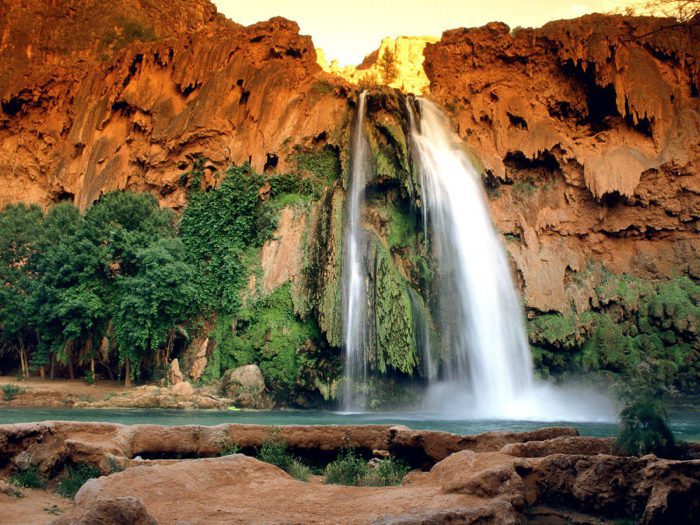The Grand Canyon is one of the most magnificent sites of the world. It is one of the “Seven Natural Wonders,” slicing 277 miles through high desert and forests of Northern Arizona. From east to west, the canyon reveals indescribable mauve and lavender-painted canyon lands. The Grand Canyon yawns a full mile deep and 18 miles wide. More than four million people visit the Grand Canyon every year. Most visit the easy-to-reach campgrounds or lodges at Grand Canyon’s central and eastern regions. A trip to the west of the Grand Canyon takes adventurous travelers off the common path. Only those hikers prepared for teetering rises and falls of the canyon should travel down the dusty roads that lead to Havasu Falls, also known as Havasupai.

The hike to the gorgeous Havasupai waterfalls located at the western end of the Grand Canyon starts at a remote hilltop more than 60 miles away from the nearest town. This is a trek challenge for anyone on any day, but freezing winter rainy days and blistering hot summer days increases the difficulty. The hike across the Havasupai reservation trail is limited to hikers, so make reservations beforehand.
Make a hike reservation in advance. Six months is not too far ahead. Call the Havasupai Tourism Office to reserve the hike and pay the fees. Each person pays an entry fee along with a group environmental care fee. Reserve a room at the Havasupai Lodge or a campsite at the same time. Without a reservation, visitors pay double the rate. Hikers with luggage can arrange for mule transport for a small charge.

Peach Springs, about 66 miles away from the Hualapai Hilltop and the start of the paved trail, winds through amazing pine, pinyon, and juniper forests to arrive at the Kaibab Plateau. A few miles before arrival at Hualapai Hilltop, the road dips into a smaller canyon. There are no bathrooms or other access to potable water at the head of the trail, but take note of the helipad or corrals. Although this is a remote location, hikers report the road and parking are extremely busy in early daylight and at late afternoon. About 500 people visit here each day. Considering the terrain it would be wise to make sure your car insurance coverage includes some kind of roadside assistance as well.
From Hualapai Hilltop, the trail descends at steep switchbacks. Over the first mile, the trail drops 1,100 feet from the starting elevation level. The descent does not abruptly change as the slope of 900 feet occurs over the seven mile distance to the village. With no shade offered for the first three miles, bring enough water per person until reaching the village. The trail becomes narrow as it traces the creek along the tributary canyon. If a mule attempts to pass hikers along this stretch, stand at the uphill trail to let it pass. Mules have the right-of-way along the trail.
At the village, check with the tourist office adjacent to the café. There are limited groceries, supplies, and beverages for sale.

Past the corrals and beyond the village, follow the trail to reach Havasupai Falls and the relaxing campground about two miles away. Hikers find a water spigot and a spring for purifying drinking water. The trail becomes more treacherous on the way to Mooney Falls. Hikers must descend through ladders and difficult travertine steps with only chain handrails to reach the falls and beyond. The four mile hike beyond the falls leads hikers to Beaver Falls. There are several high water creek crossings to traverse along the way. Past Beaver Falls, an additional four miles of the trail brings hikers to the Havasu Falls of the Colorado River.

Temperatures reach 100 degrees Fahrenheit by early May. If hiking from the Northern Rim, begin the hike at first light because hikers are exposed to south-faced sun for the hike’s duration. May and October are the busy months because the weather is mildest.
July and August monsoon rains, thunder and lightning are demonstrations of the power of nature. Temperatures drop in late summer, so it is important to travel with storm gear. Access to the Northern Rim is more difficult in the snowstorm season from January to March.
Have you ever visited Havasu Canyon before? Leave us a question or comment below!
Counter
101 Countries • 1432 Cities